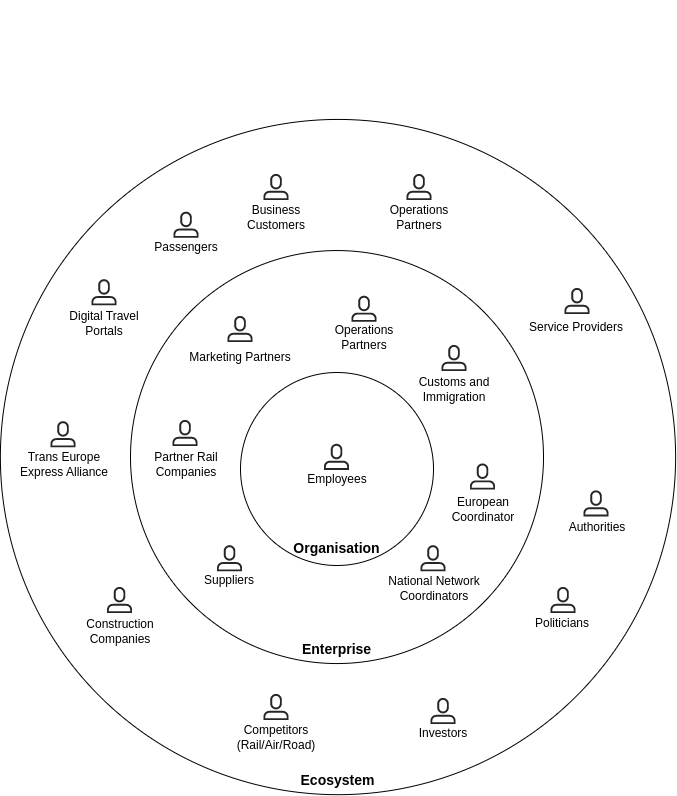No edit summary |
|||
| Line 1: | Line 1: | ||
=People= | ={{element|Element-People|People}}= | ||
<span class="Def">The individuals co-creating the enterprise or using products.</span> | |||
==Description== | ==Description== | ||
People are individuals with an identity, motivation and intent, skills | People are individuals with an identity, motivation and intent, skills and expertise, background, story and personality. They have the unique ability to have ambitions, find meaning and purpose in the world, and share those with other people. The roles people play in an enterprise (for example customer, partner or owner) relate to the activities they are expected to be involved in. | ||
and expertise, background, story and personality. The roles people | |||
play in an enterprise relate to the activities they are expected to be | A weakness of people is their unpredictability. A strength is their resilience, especially in unexpected situations. These human characteristics enable people to recover gracefully from disruptive situations, learn from mistakes and produce new enterprise value, where automated systems tend to fail and stay broken. | ||
involved in. A weakness of people is their unpredictability. A strength | |||
is their resilience, especially in unexpected situations. These human | |||
characteristics enable people to recover gracefully from disruptive | ==People Map== | ||
situations, learn from mistakes and produce new enterprise value, where | [[File:EDGY-People-Map-Stakeholder-Map.png]] | ||
automated systems tend to fail and stay broken. | Also known as [[Stakeholder]] Map. | ||
==Examples== | ==Examples== | ||
A manufacturing business makes goods for private household customers and relies on investors and suppliers. | |||
An open-source software company works remotely with thousands of independent developers. | |||
An NGO works with volunteers to run campaigns and make their case to parliamentarians around the world. | |||
A startup company runs a two-sided marketplace to connect buyers and sellers on its digital platform. | |||
A medical research lab works with doctors, scientists and research participants to conduct their studies. | |||
==Use== | ==Use== | ||
*Understand the reason people play a certain role by identifying their identity. | *Understand the reason people play a certain role by identifying their identity. | ||
*Understand the ownership and influence of people on the various parts of the enterprise design. | *Understand the ownership and influence of people on the various parts of the enterprise design. | ||
| Line 26: | Line 30: | ||
*Design new products by identifying potential customers and analysing their identities. | *Design new products by identifying potential customers and analysing their identities. | ||
*Identifying future partners and describing them in terms of their identity. | *Identifying future partners and describing them in terms of their identity. | ||
==Related== | ==Related== | ||
*people perform activities | |||
* | *people use objects | ||
* | *people achieve outcomes | ||
* | *people pursue purpose | ||
* | *people co-create capabilities | ||
* | *people get tasks done | ||
*people collaborate in organisations | |||
*people use products | |||
*people perceive brands | |||
==Suggested Labels== | |||
*employee, customer, partner, investor, regulator (tag) | |||
*engagement level (metric) | |||
Revision as of 16:49, 21 March 2023
People
The individuals co-creating the enterprise or using products.
Description
People are individuals with an identity, motivation and intent, skills and expertise, background, story and personality. They have the unique ability to have ambitions, find meaning and purpose in the world, and share those with other people. The roles people play in an enterprise (for example customer, partner or owner) relate to the activities they are expected to be involved in.
A weakness of people is their unpredictability. A strength is their resilience, especially in unexpected situations. These human characteristics enable people to recover gracefully from disruptive situations, learn from mistakes and produce new enterprise value, where automated systems tend to fail and stay broken.
People Map
 Also known as Stakeholder Map.
Also known as Stakeholder Map.
Examples
A manufacturing business makes goods for private household customers and relies on investors and suppliers. An open-source software company works remotely with thousands of independent developers. An NGO works with volunteers to run campaigns and make their case to parliamentarians around the world. A startup company runs a two-sided marketplace to connect buyers and sellers on its digital platform. A medical research lab works with doctors, scientists and research participants to conduct their studies.
Use
- Understand the reason people play a certain role by identifying their identity.
- Understand the ownership and influence of people on the various parts of the enterprise design.
- Identify the people with the required background to realise a capability.
- Design new products by identifying potential customers and analysing their identities.
- Identifying future partners and describing them in terms of their identity.
Related
- people perform activities
- people use objects
- people achieve outcomes
- people pursue purpose
- people co-create capabilities
- people get tasks done
- people collaborate in organisations
- people use products
- people perceive brands
Suggested Labels
- employee, customer, partner, investor, regulator (tag)
- engagement level (metric)